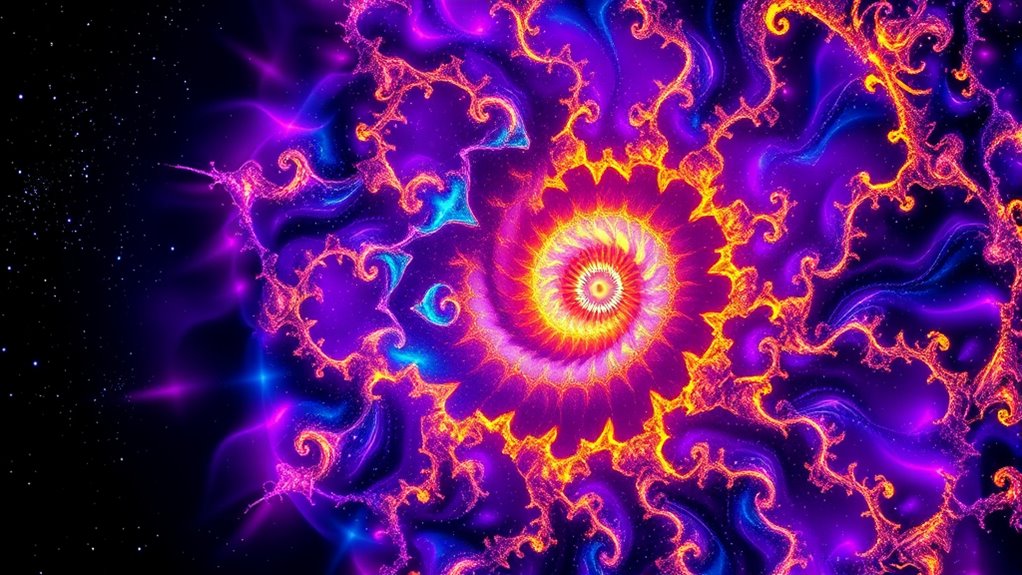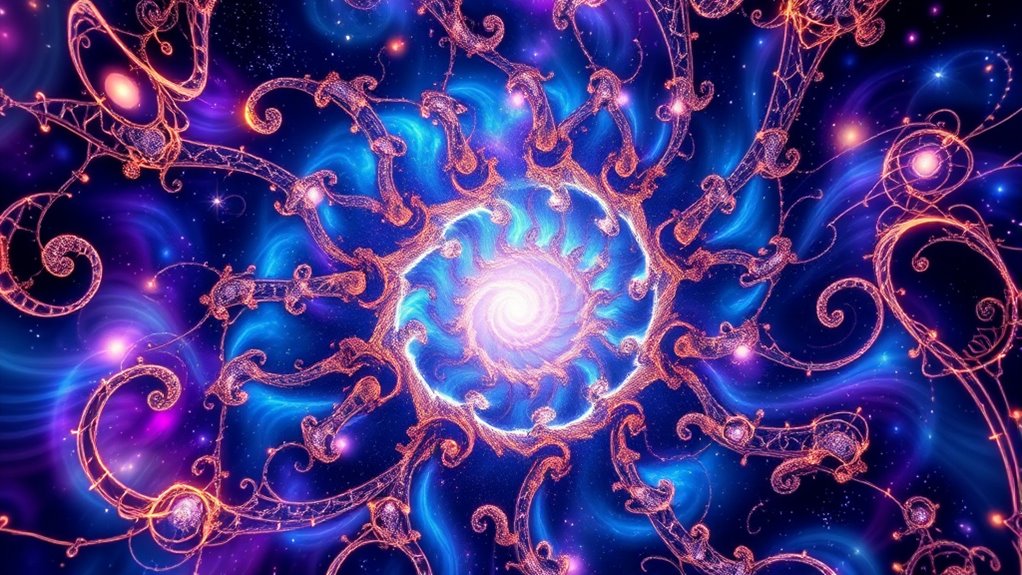Fractals help you see how the universe’s vast structures mirror each other through self-similar patterns across different scales. From galaxies to superclusters, these patterns repeat, revealing an intricate, layered architecture. This means the cosmos isn’t random but has underlying geometric principles shaping its form. Exploring this connection can open your understanding of cosmic evolution, dark matter, and the universe’s hidden order. If you’re curious, there’s much more to uncover about these fascinating patterns.
Key Takeaways
- Fractals exhibit self-similarity, mirroring structures across different cosmic scales like galaxies and superclusters.
- The universe’s large-scale structure may follow fractal patterns, indicating a complex, layered architecture.
- Fractal geometry helps model cosmic clustering and distribution, revealing underlying order in the universe.
- Recognizing fractal patterns offers insights into cosmic evolution, dark matter, and the universe’s fundamental organization.
- Applying fractal concepts bridges chaos and order, enhancing understanding of the universe’s intricate and layered design.

Have you ever wondered if the universe itself exhibits patterns that repeat at different scales? This question leads you into the fascinating world of fractals and how they can help explain the cosmos’s complex structure. Fractals are geometric shapes characterized by self similarity patterns, meaning each part mirrors the whole, no matter how much you zoom in or out. When you look at natural phenomena, from coastlines to snowflakes, you see these patterns repeating endlessly. Now, imagine applying this concept to the universe itself. Many scientists believe that the large-scale structure of the cosmos might follow similar principles, where galaxies, clusters, and superclusters form a vast, self-similar network. This idea is central to cosmic scale modeling, where you treat the universe as a fractal-like entity. Instead of seeing the universe as a uniform, smooth expanse, you recognize a pattern of clustering that repeats across different scales, suggesting a kind of cosmic fractal geometry.
By understanding self similarity patterns in the universe, you can develop models that better describe its structure. These models propose that the distribution of matter isn’t random but follows a fractal pattern, with similar clustering behaviors at different levels. For instance, the way galaxies group together resembles smaller-scale structures, like star clusters, which in turn resemble larger formations like superclusters. This recursive pattern hints at an underlying order that fractal geometry can help quantify. You might think of the universe as a vast, unfolding fractal, where each level of structure reflects the larger pattern. This perspective challenges traditional views of a smooth, homogeneous universe, offering instead a layered, self-similar architecture. Such models could revolutionize your understanding of cosmic evolution, dark matter distribution, and the forces shaping the cosmos.
Additionally, some researchers explore the possibility that the universe’s matter distribution follows a fractal pattern across cosmic scales, which could have profound implications for fundamental physics. Furthermore, using fractal geometry in cosmic scale modeling allows you to analyze vast datasets more effectively. Instead of trying to fit the universe into simple Euclidean shapes, you recognize that its true nature might be fractal. This approach helps unify observations across different scales, revealing the repeating patterns buried within the cosmic web. In essence, by exploring self similarity patterns and applying fractal principles, you’re opening new pathways to comprehend the universe’s intricate design. You become a cosmic detective, uncovering the hidden fractal fingerprints that bind galaxies and clusters into a grand, self-repeating tapestry. This insight not only deepens your understanding of the universe but also highlights the profound connection between geometry, chaos, and order at every scale.
Frequently Asked Questions
How Do Fractals Influence Our Understanding of Dark Matter?
You see, fractals influence your understanding of dark matter by revealing a fractal distribution in the universe, which suggests that dark matter forms a complex scaffolding. This scaffolding guides galaxy formation and cosmic structure, helping you grasp how dark matter isn’t evenly spread but follows self-similar patterns. Recognizing this fractal pattern enables you to better comprehend the large-scale structure of the universe and the role dark matter plays within it.
Can Fractal Geometry Predict Cosmic Microwave Background Patterns?
Think of fractal patterns as the cosmic fingerprints that can reveal the universe’s secrets. While they don’t directly predict the cosmic microwave background patterns, they offer valuable insights in cosmic analysis, helping you understand large-scale structures. Fractal geometry’s self-similarity could hint at underlying universal principles, making it a powerful tool in deciphering the universe’s earliest signals and enriching your understanding of the cosmos’s intricate tapestry.
Are Fractals Present in the Structure of Black Holes?
Yes, fractals appear in black hole structures through fractal singularities and self-similar horizons. You can see how these features exhibit repeating patterns at different scales, indicating fractal behavior. These self-similar horizons suggest complex, recursive structures near the event horizon. Studying these fractal aspects helps you understand black hole dynamics and the nature of spacetime, revealing a fascinating connection between fractal geometry and cosmic phenomena.
How Do Fractals Relate to the Multiverse Theory?
You see, fractals relate to the multiverse theory through self-similar patterns that suggest infinite complexity. These patterns, repeating at every scale, hint at the possibility that our universe might be just one of many, each with its own intricate structure. By studying fractals, you explore how similar designs could emerge across different universes, revealing a deep connection between complex geometry and the multiverse concept.
What Role Do Fractals Play in Galaxy Formation?
Imagine swirling galaxies as cosmic rainbows, where self-similar patterns emerge within the vast darkness. Fractals guide galaxy formation through hierarchical clustering, where smaller structures merge into larger ones, creating a grand cosmic tapestry. These self-similar patterns shape the universe’s architecture, revealing how galaxies grow and organize themselves. You see, fractals provide the blueprint for understanding the universe’s intricate, repeating design on an immense scale.
Conclusion
So, next time you gaze up at the universe’s intricate patterns, remember—you’re just marveling at a cosmic fractal, perfectly designed to keep us humble. Clearly, the universe’s obsession with self-similarity suggests it’s got a sense of humor, or perhaps a cosmic itch to keep us guessing. Either way, isn’t it comforting to think that the grandest mysteries are just nature’s way of playing fractal hide-and-seek? Truly, the cosmos never gets tired of showing off.










